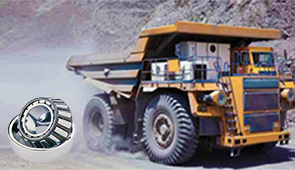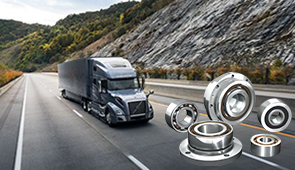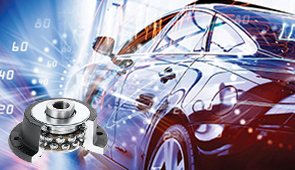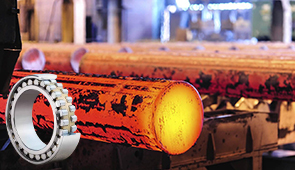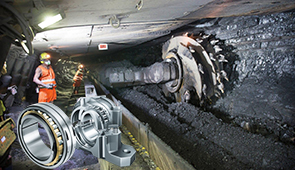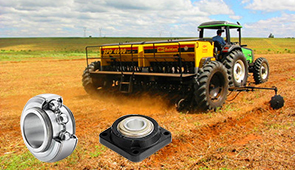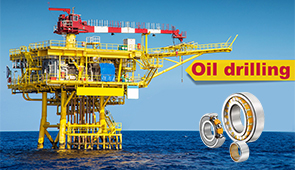Ultimate Guide to Ball Joint Rod End Bearings: Everything You Need to Know About Spherical Hardware
Ball joint rod end bearings, often referred to as spherical rod ends or heim joints, are critical components in a wide variety of mechanical systems. From automotive suspensions to industrial machinery, these versatile pieces of hardware provide a pivotal connection that accommodates both rotational and angular misalignment. Their unique design and robust functionality make them indispensable in applications requiring smooth motion and high durability under demanding conditions. This guide serves as a comprehensive resource to help readers understand the key aspects of ball joint rod end bearings, including their construction, types, uses, and maintenance considerations, offering a detailed framework for both beginners and industry professionals.
What is a Ball Joint Rod End Bearing and How Does It Work?
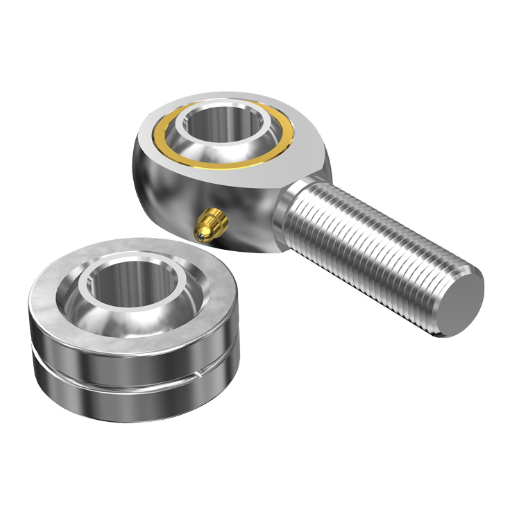
Understanding the Design and Function of Spherical Rod End Bearings
Ball joint rod end bearings or spherical rod end bearings are advanced engineered machines with a wide variety of uses. The bearings have an inner ring of a sphere that freely rotates within an outer shell of a sphere which shifts the motion and serves the transfer of load, or the movement of parts. These bearings do wonders wherever there are both, radial and axial forces present.
- Static load capacity: This is described in terms of kilonewtons (kN), and in a more practical sense means, the highest degree of radial or axial load a pedestal bearing can take without damaging its form or shape. This guarantees structural reliability for difficult tasks.
- Dynamic load capacity: Measured in the same unit, it reflects the bearing’s ability to handle repetitive or oscillating forces over its operational lifespan.
- Misalignment angle: Said in degrees this angle specifies the maximum allowable angular deviation which is normally between ±4° to ±15° depending on the design and how it will be used.
- Dimensional Tolerances: These are determined with the tolerances for their interface given by the standard such as bore of a dimensioned shaft and a housing shown in ISO 12240 for fitting and alignment for housing parts.
These factors, together, guarantee the effectiveness and efficiency in the performance of spherical rod end bearings, keeping them in high importance in sectors such as automotive suspensions, aerospace linkages, and industrial machinery.
Different Types of Rod End Bearings: Male Thread vs Female Thread Options
The rod end bearings can be categorized into two types: male-threaded and female-threaded types, and this is determined by the shaping of the threading of its shank portion. Male threaded rod end bearings have a threaded external shank which can be directly affixed to the relevant parts with internal threads. In contrast to this, female threaded rod end bearings have an external mating part with an internally threaded shank to which the shank can be attached.
- Load Requirements: Female threaded variants tend to be more compact which is advantageous in areas of tight spatial limitation.
- Space Constraints: As rod end bearings are more compact, they can be used in a certain assembly where the available space is limited.
- Thread Size Compatibility: The threads should meet the industrial requirements for the specific measuring standards for threads like ISO 965 or ASME B1.1 about the other mating components to not cause gaps.
- Application-Specific Needs: Female threaded bearings may be easier to lose and as such more useful for movable compliant systems that require frequent disassembly.
Maintaining these constraints allows for the choice of the suitable rod end bearing type with the system design and mechanisms performance working optimally.
How Ball Joint Rod Ends Allow for Misalignment and Articulate Motion
Controlled articulation and misalignment in motion are accomplished by the ball joint rod end functionality. These components have spherical bearings that allow rotation and internal angular movement about a central point which provides flexibility to accommodate axial, radial, or angular loads. Operational misalignment leads to overstepping boundary conditions but flexibility allows smooth operation within the limits.
- Spherical Radius Tolerance: Articulation when coupled with load or force distribution needs precision manufacturing with tight tolerance for example ISO 12240-1 standards.
- Housing Material: For fatigue resistance under dynamic loads, High-strength alloys or stainless steel are often used.
- Friction Coefficients: Self-lubricating liners or PTFE coatings enhance the longevity with the minimum wear by ball joint rod ends
- Operating Angle: With dependance on model type and load, maximum misalignment angle can range between 10 degrees to 30 degrees.
With the integration of these factors, movement for structural and mechanical systems under different dynamic conditions is easily facilitated by ball joint rod ends.
What Materials Are Rod End Bearings Made From?
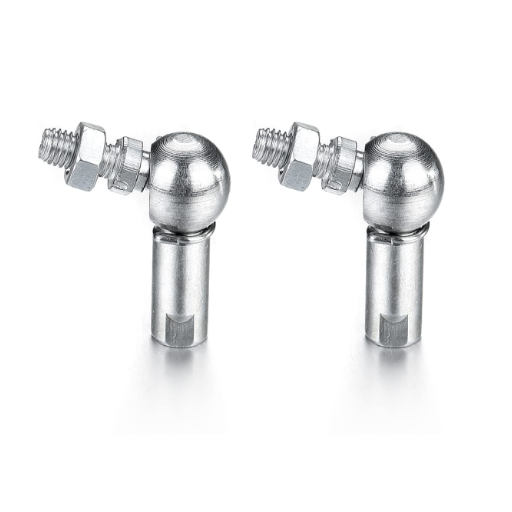
PTFE and Self-Lubricating Rod End Bearing Options
Having dealt with the PTFE and self-lubricating rod end bearings, I am quite certain that these parts are designed to work exceptionally well in difficult environments. Because PTFE (Polytetrafluoroethylene) liners are employed widely, owing to their low friction and self lubricating characteristics which do not need any form of external lubrication, they reduce maintenance costs and extend service life.
The operating reliability ranges of a PTFE liner residing between -65°F to 250°F (-54°C to 121°C) are heavily dependent on the rod end’s design, and material composition. Their excellent wear resistance makes them suitable for high oscillatory movement at high loads. These particulars of self-lubricating rod ends make them very useful in cases where heavy machinery, aerospace systems, or parts needing protection from grease and oil contamination are to be used.
Often these rod ends are made with high-strength steel or stainless steel sections to increase the durability whilst providing smooth motion under load and misalignment conditions by the PTFE liner. Their effective management of static and dynamic loads makes them quite useful, with their typical range of load capacity being decided by manufacturers to meet application demands.
Material Selection Based on Loading Requirements
Concerning my loading requirements for material selection, I narrow it down to a certain selection of considerations for effectiveness and longevity. Firstly, it is crucial to look at the type of load in question along with its static, dynamic, or cyclic nature. This is due to the fact different materials have differing fatigue resistances and strength characteristics. For instance, carbon steel, owing to its strength, has often been proven to be rather effective when managing static loads. On the other hand, dynamic or cyclic loads will need materials, such as titanium alloys or stainless steel, with better fatigue resistance.
- Tensile Strength (MPa): The material’s capacity to bear the maximum load withstanding failure is critical. For instance, carbon steel is known to have tensile strength of 400 – 550 MPa, while varying grades of stainless steel have unattainable tensile strengths of 500 – 750 MPa.
- Fatigue Limit (MPa): These limits are most challenging for repetitive loaded bearers, where stainless steel shows some hope with lower fatigue limits than ~250 MPa for average applications.
- Corrosion Resistance: Where there is a threat of high moisture or a chemical environment, the preferred materials will need to have protective coatings of stainless steel or other such material.
Furthermore, the materials weight and its thermal density need to be aligned with the operating temperatures. Each and every one of the factors relates in such a manner that expectations of durability and particular application demands can be achieved.
How to Choose the Right Rod End Bearing for Your Application?
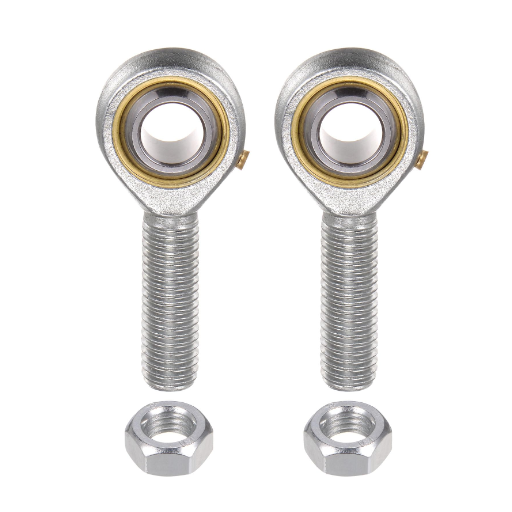
Right Hand Thread vs Left Hand Thread: When to Use Each
Choosing between right hand thread and left hand thread rod end bearings is determined by specific application parameters and the loading forces at play. In most cases, right hand threads are preferred because most elements in a machine are usually standard-threaded and need minimal attention for assembly. Moreover, they can be tightened with a clockwise motion, ideal for general-purpose connections that do not have load-dependant adjustments.
However, some applications may need counterclockwise motion to adjust or maintain the tension, necessitating the use of left-hand threads. These types of threads are often bundled with right-hand threads in opposing arrangements which are common in most linkage assemblies, for example, turnbuckles, where the need for simultaneous tightening and loosening is common without removing the individual components.
- Direction of Load and Adjustment Detailing: Evaluate if the application is unidirectional or bi-directionally tensioned.
- Threading Support: Check for the presence of other standard parts in the assembly that may contain right-hand threads.
- Type of Application: Limit left hand threads use to control linkages and adjustable suspensions where reverse-threading yields a mechanical benefit.
Through coordination of these boundaries and the operating objectives, I am in a position to make the appropriate selection of the thread type that optimizes functionality as well as reliability.
Load Capacity and Spherical Inner Ring Considerations
During the load capacity and spherical inner ring performance evaluations, the technical requirements that need to be analyzed ensure proper functionality and mechanical reliability:
- Dynamic Load Rating (C): Calculating radial and axial forces as the Load that the bearing can support when it is functioning continuously is critical to estimate.
- Static Load Rating (C0): Measures the bearing’s ability to support loads when stationary without risking structural damage. Ensure this value exceeds peak static force scenarios.
- Misalignment Tolerance: The spherical inner ring is supposed to be designed to cater for angular misalignments ranging typically from ±1° to ±3° depending on the application needs.
- Material Strength: The inner ring needs to be made of materials with high strength such as chrome steel (AISI 52100) or the like characterized by having high wear and deformation resistance.
- Load Distribution: Make sure that the load distribution is uniform across the contact surface to avoid localized stress points which can lead to premature failure.
- Calculation of Fatigue Life: Calculate the estimated operating hours to bearing fatigue using the L10 life criteria, considering the expected cyclic loading conditions.
Spherical Bearings, by tailoring these factors to meet specific application requirements, in a set boundary condition of load shall remain intact geometrically and structurally while reducing the need for maintenance.
What Are the Common Applications for Ball Joint Rod End Bearings?

Industrial Machinery Applications for Spherical Rod Ends
Misalignment, oscillatory motion, and high load-bearing features make spherical rod end bearings widely used between different types of industrial machinery. These parts have a place in applications like hydraulic cylinders, conveyors, and robotic arms that require precise control and performance. Due to their capacity to bear both radial and axial loads, they are well-suited for dynamic and repetitive motion systems.
- Load Ratings: Ensure reliability by doing a check of the application’s maximum load requirements against both the static and dynamic load capacities.
- Operating Temperature Range: Limit properties must be verified for the materials in question so that their performance is not affected by the expected temperature limits. For regular bearings, those limits are normally -30 Celsius to +150 Celsius.
- Angular Misalignment Tolerance: Check the maximum angle of misalignment which would produce no additional bearing wear to evaluate the amount of misalignment allowed.
- Material Selection: For use in harsh environments, pick materials which offer corrosion protection like stainless steel or alloy steel with surface treatments.
- Lubrication Compatibility: Check if the lubrication surface requirements of the bearing match the maintenance cycles and operation conditions of the industrial system. Self-lubricating bearings may be beneficial for high-frequency applications by minimizing maintenance.
The integration of spherical rod ends selected through these factors can improve industrial machinery performance relating to robustness, reduced downtime, and accuracy under extreme working conditions.
Steering and Tie Rod End Applications
The steering components and the tie bar rod ends are intricate parts in automobiles and heavy machinery, particularly in the steering system’s accuracy and steadiness. These parts help to apply the force from the steering rack to the steering knuckle to enable control of direction with the allowance for motion in multiple directions as well as outside friction.
- Material Selection: In terms of material, I recommend that components be fabricated using forged or alloyed steels that have outside coatings such as zinc and phosphate for better corrosion resistance and an increased service life. These materials ensure the component survives environmental impacts as well as drastic heavy loading conditions.
- Load and Range Specifications: In relation to load capacity, I would suggest including components that are capable of withstanding dynamic tensile loading of roughly 15k Newtons and over 10k Newtons of compressive forces when the unit is functioning. The operational angular range that should be utilized is about ±25 degrees for effective steering movement.
- Performance and Durability Justification: Self-lubricating inserts or sealed type designs can provide increased functional life through reduced friction and safeguards internal moving components from external debris.
- Installation and Maintenance: Providing a modular type system of installation with appropriately positioned grease nipples offers ease of performing routine maintenance that applies to both automated and manual servicing regimes in an industrial or automotive setting.
These factors when incorporated into the design of steering and tie rod ends ensure that they are able to perform adequately under harsh working conditions and remain safe, efficient, and reliable.
Cylinder and Motion Control Using Rod End Bearings
Rod end bearings serve a specific function in the sphere of cylinder motion control by providing articulation and load transfer. These bearings are a part of linkage mechanisms where rotation is permitted with the components being connected.
- Material Composition: High-performance steel alloys of the best quality , along with protective coverings such as zinc or nickel plating, guarantee resistance to abrasive environments and corrosion.
- Load Capacity: For operational safety, bearings with static and dynamic load capacity justified by application-specific requirements (for instance, up to 20 kN for medium-duty industrial cylinders) must be selected.
- Lubrication System: For constant movement, pre-lubricated designs or those accepting grease minimize friction and increase the service life of the bearing.
- Operational Angles and Misalignment Tolerance: Rod ends are designed with a tolerance for misalignment up to ±15° to accommodate performance without loss in angular variation.
- Threading Standards: Compliance with industry standards of metric M8-M20 or UNF threading guarantees integration with existing system of actuators.
Taking into consideration these factors, rod end bearings can increase the precision of motion control, minimize wear, and extend the life cycle of the actuator system.
How to Install and Maintain Rod End Bearings?

Proper Installation Techniques for Male and Female Rod Ends
All rod end bearings function optimally when installed using stringent practices, as such practices guarantee accurate clearances and extend service life. The following steps are how I suggest completing this task:
- Thread Preparation: Ensure the threaded interfaces on the male and female rod ends are devoid of contaminants such as dirt, grease, and other debris. These ensure there is no interference during assembly, and mechanical integrity is maintained.
- Alignment Verification: It is always recommended that the alignment of the rod end bore and the mating component be checked before the operation. A lack of proper alignment can lead to undue stress concentrations and accelerated wear.
- Torque Application: To avoid over or under-tightening, the rod ends must be secured through the use of specially calibrated mechanical torque devices. For example, the metric thread sizes of M10 will usually be needed in the region of 35-40 Nm of tightening torque, depending on material and load conditions.
- Lubrication Requirements: Apply the correct lubricant as specified (often grease with EP ratings). Proper lubrication reduces friction, especially for rod ends operating under high loads or repetitive motion.
- Sustaining Locking Devices: For secure and robust purposes, locking nuts or safety clips should be used on assemblies where applicable. This prevents rotating loosening during dynamic actions.
Through these steps, operational failures can be dramatically reduced with custom-designed rod end bearings that guarantee reliable functionality in specified conditions and risk escalation during operations.
Maintenance Requirements for Ball Joint Rod End Bearings
To ensure efficient wear and tear of ball joint rod end bearings, I observe several crucial steps that guarantee maximum utility and enhanced performance:
- Regular Inspection: I carry out routine inspections which are both visual and physical to check for any form of scratches, corrosion, or deformation. This entails checking the ball’s surface finish to see that it is smooth while simultaneously checking the housing for any signs of fractures or damage.
- Lubrication: Depending on the bearing style, I apply the appropriate lubricant at set time intervals. For self-lubricating rod ends, no further grease is necessary, while for standard forms, a grease that will not thermally breakdown is utilized such as lithium grease for temperatures if up to 120 degrees centigrade.
- Load and Misalignment Monitoring: I check that operational forces are within the rated dynamic load condition. For instance, making sure that medium duty systems loads do not exceed a rating of 20 kN and checking to ensure that angular misalignment is within safer operating limits of ±15°.
- Thread Security: The integrity of the threads and the locking mechanism engagement of at least 1.5 times the thread diameter in length is routinely checked. This helps ensure that the connection is operationally stress secure.
- Environmental Protection: In situations where contamination like dust, water, or chemicals might occur, I utilize protective resources such as seals and covers. For harsh environments, I check the corrosion resistance of the material such as with stainless steel or zinc surfaces.
Careful tracking of these steps along with these requirements’ technical descriptions guarantees system dependability and that the bearings functions correctly, avoiding loss during unscheduled downtime.
Frequently Asked Questions (FAQs)
Q: What are the key features of ball joint rod end bearings as a product?
A: Ball joint rod end bearings, also known as heim joints, are self-aligning bearings that allow for angular rotation and oscillation between connected parts. Their key features include accommodating misalignment, reducing friction, absorbing shock, and providing pivotal movement in multiple planes. These products come in various configurations including male and female threads, with options for steel ball or chromoly construction depending on load requirements. Most quality rod ends also feature heat-treated bearing steel for durability and can include dust seals or rubber boots for protection against contaminants.
Q: How do steel ball rod ends compare to chromoly options in performance?
A: Steel ball rod ends typically use bearing steel for the ball component, offering good durability and load capacity at a reasonable cost. They’re suitable for most industrial and automotive applications. Chromoly rod ends, made from chromium-molybdenum alloy steel, offer superior strength-to-weight ratio, higher tensile strength, and better fatigue resistance. Chromoly options excel in high-stress environments like motorsports, off-road equipment, and performance auto applications where weight savings matter. While chromoly rod ends typically cost more than standard steel ball options, they provide enhanced durability under extreme conditions and can handle higher shock loads, making them ideal for racing and high-performance linkage systems.
Q: What’s the difference between metric rod end bearings and inch-sized options?
A: The main difference between metric rod end bearings and inch-sized options is their measurement system and thread specifications. Metric rod ends use millimeter dimensions and metric thread pitches conforming to international standards, while inch-sized rod ends use imperial measurements and unified thread standards (UNF/UNC). This affects compatibility with mating components, as they cannot be interchanged without adapters. Metric rod end bearings are common in European and Asian machinery, while inch-sized rod ends are prevalent in American-made equipment.
Q: What special features should I look for when selecting rod end bearings for specific applications?
A: When selecting rod end bearings, consider these key features based on your application: material composition (steel, stainless steel, or chromoly for high-strength needs); temperature resistance for extreme environments; sealing options (metal shields or rubber seals for dusty/wet conditions); self-lubricating capabilities for maintenance-free operation; load ratings appropriate for your equipment; thread type (right or left-hand); and special coatings for corrosion resistance. For high-precision applications, look for rod ends with minimal radial play. Some specialized features include Teflon liners for reduced friction, boot covers for contamination protection, and vibration-dampening elements. Premium rod ends often include these features while offering enhanced durability specifications compared to standard options.
Q: How do threaded rod end help with equipment maintenance and repair?
A: Threaded rod ends help significantly with equipment maintenance and repair by offering easy adjustment and replacement capabilities. Their threaded design allows for precise alignment adjustments without complete disassembly of linkage systems. This feature is particularly valuable in automotive suspension systems, industrial machinery, and hydraulic equipment where maintaining proper alignment is critical. Rod ends help extend equipment life by absorbing vibration and compensating for misalignment that would otherwise cause premature wear. When components do eventually wear, the modular nature of rod end bearings allows for the replacement of just the worn bearing rather than entire assemblies, reducing maintenance costs. For equipment subjected to regular movement, self-aligning rod ends help prevent binding and stress concentration that can lead to catastrophic failures.
Q: How do I determine the correct specifications when ordering ball joint rod end bearings?
A: When ordering ball joint rod end bearings, you need to determine several key specifications: thread size and type (metric rod end or inch, right or left-hand thread), bore diameter of the spherical bearing, load rating appropriate for your application, material requirements (standard bearing steel, stainless steel, or chromoly for high-strength needs), and housing type (male or female). You should also specify any special requirements like seals for dust protection, temperature range, or self-lubricating features. For direct replacements, check the existing part number or measure the current bearing’s dimensions. Consider whether your application involves rotation, oscillation, or both, as this affects bearing selection.
UCTH213-40J-300 with Setscrew(inch)
CNSORDERNO: Normal-duty(2)
TOGN: UCTH213-40J-300
SDI: B-R1/8
SD: 2 1/2
UCTH212-39J-300 with Setscrew(inch)
CNSORDERNO: Normal-duty(2)
TOGN: UCTH212-39J-300
SDI: B-R1/8
SD: 2 7/16
UCTH212-38J-300 with Setscrew(inch)
CNSORDERNO: Normal-duty(2)
TOGN: UCTH212-38J-300
SDI: B-R1/8
SD: 2 3/8
UCTH212-36J-300 with Setscrew(inch)
CNSORDERNO: Normal-duty(2)
TOGN: UCTH212-36J-300
SDI: B-R1/8
SD: 2 1/4
UCTH211-35J-300 with Setscrew(inch)
CNSORDERNO: Normal-duty(2)
TOGN: UCTH211-35J-300
SDI: B-R1/8
SD: 2 3/16
UCTH211-34J-300 with Setscrew(inch)
CNSORDERNO: Normal-duty(2)
TOGN: UCTH211-34J-300
SDI: B-R1/8
SD: 2 1/8









